文章信息
- 陈梦齐, 刘紫丹, 戴文芳, 叶仙森, 梁新友, 熊金波
- CHEN Mengqi, LIU Zidan, DAI Wenfang, YE Xiansen, LIANG Xinyou, XIONG Jinbo.
- 象山港电厂温排水增温对浮游细菌群落空间分布的影响
- Effects of thermal discharge on the spatial distribution of bacterioplankton community near a power plant in Xiangshan Bay
- 生态学报[J]. 2016, 36(20): 6574-6582
- Acta Ecologica Sinica[J]. 2016, 36(20): 6574-6582
- http://dx.doi.org/10.5846/stxb201504010652
-
文章历史
- 收稿日期: 2015-04-01
- 网络出版日期: 2016-04-11
2. 宁波海洋环境监测中心站, 宁波 315040;
3. 浙江海洋高效健康养殖协同创新中心, 宁波 315211
2. China Marine Environmental Monitoring Center of Ningbo, State Oceanic Administration, Ningbo 315040, China;
3. Collaborative Innovation Center for Zhejiang Marine High-efficiency and Healthy Aquaculture, Ningbo 315211, China
为满足工业和经济的高速发展对电力日益增长的需求, 近20年来我国东部沿海地区兴建了大量电厂。这些电厂排放的冷却水把巨大的热能传递到附近海域, 致使水温高于周围水域2—8℃[1-3]。海水温度升高引起的生物病害和赤潮暴发的案例在世界各地均有报道[4-6]。我国现行的《海水水质标准》(GB 3097—1997)已将海水升温超过当时当地温度的幅度作为水质评价指标;并通过监测浮游动、植物的多样性和组成来评价增温的影响, 而缺乏浮游微生物如何响应海水增温的研究。
近年来, 由于国家对环境可持续发展的重视, 滨海电厂温排水对周围海域生态系统的影响受到人们的日益关注[2-3]。大量研究结果表明电厂温排水增温已经对浮游植物和动物产生了一些负面影响[7], 如:赤潮暴发时间提前、频率增加[8];浮游植物群落改变[2, 9];浮游动物优势种变化、多样性降低[10-11]及周转速率加快[1]。尽管浮游微生物在微食物网平衡中发挥着核心作用, 但是却缺少在物质能量循环过程中起纽带作用的微生物对温排水增温响应的研究[12-13]。在全球气候变暖背景下, 实测和模型预测数据均认为海水会加速增温, 到本世纪末海水增温幅度为1.1—6.4 ℃[14], 具体的增温幅度取决于微食物网中浮游植物的初级生产力和异养微生物降解间的平衡[6, 15]。此外, 浮游细菌对增温能够做出快速和灵敏的响应, 这种响应遵循增温幅度-效应关系[16-17]。持续的环境选择压力能够降低微生物的随机增殖, 选择适应环境的种群[18-19]。可见, 通过研究细菌群落结构对温排水的响应, 建立特定种群和增温幅度间的相互关系, 实现利用敏感的细菌种群来评价温排水的微生态效应在理论上是可行的。然而, 类似的研究在近海生态系统中还较缺乏。
目前, 国内外学者针对海水增温对浮游生物的影响开展了一些研究, 为评价增温的微生态效应提供了基础。但主要利用浮游动、植物多样性和组成作为指标来评价海水增温的微生态效应[1-2, 9-10]。有研究表明异养微生物的代谢相比于浮游植物的初级生产力对增温更加敏感[20]。可见, 研究浮游微生物对增温的响应是对以浮游植物净生产量表征增温生态效应的重要补充, 同时也能更准确和灵敏地反映海水增温对生态系统的影响。因此, 本研究在象山港乌沙山电厂温排水的强增温海域进行浮游细菌群落结构和多样性研究, 目标是揭示该海域:(1)浮游细菌群落结构和多样性对温排水的响应规律及空间变化特征; (2)影响群落结构的环境因子及它们对群落变异的相对贡献; (3)筛选与增温幅度相关的指示细菌科。研究结果有助于了解电厂温排水对浮游细菌群落的影响, 并筛选到潜在的指示细菌种群来评价海水增温的微生态效应;为海洋行政主管部门决策管理提供基础数据。
1 实验方法 1.1 实验设计与采样乌沙山大唐火力发电厂位于象山港主港(西侧至对山)深槽的西部。2006年底, 浙江大唐乌沙山发电厂的4台4 × 600 MW超临界燃煤机组开始运行。2014年12月12日, 随国家海洋局宁波市海洋环境监测中心站的走航船采集了表层海水样品(图 1)。采样站点为中心站环评常年监测站点, 地理坐标范围为29°32′00″—29°32′30″N, 121°37′30″—121°41′15″E。在温排水口水流梯度3个(排水口2、排水口4、排水口6)、左侧4个(左侧1、左侧4、新增1、新增3)、右侧3个(右侧1、右侧3、右侧5)(五角星标记站点)和横山码头外侧W8为对照点(图 1)。为了统计分析, 在W8站点10 m2范围内采样了3次水样作为重复, 共计14个水样。
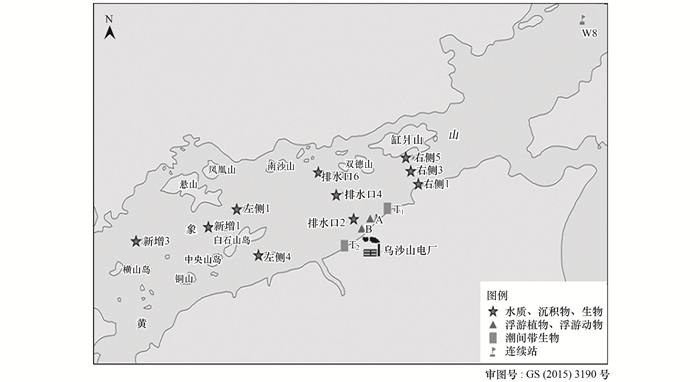
|
| 图 1 采样站点示意图 Fig. 1 Distribution of sampling sites |
采样时的海水温度、pH、溶解氧(DO)和盐度用对应的探头(Sea-Bird)原位测定。其它理化指标, 包括磷酸盐(PO43-)、硝氮(NO3-)、亚硝氮(NO2-)、氨氮(NH4+)、化学需氧量(COD)和石油类油污物(Oil)浓度根据《海洋监测规范》(GB17378—2007)的标准方法测定。叶绿素用二甲基甲酰胺萃取, 分光光度计在647 nm和665 nm是测定吸光值, 根据公式Chl a=12.70A665-2.79A647计算叶绿素a浓度[21]。
1.3 微生物的DNA抽提和16S rDNA基因Illumina高通量测序水样经100 μm孔径的尼龙网预过滤, 然后用0.22 μm聚碳酸酯膜(Millipore, Boston, MA, USA)过滤收集微生物。滤膜用无菌剪刀剪碎后用Power Soil® DNA Isolation Kit试剂盒(MO Laboratories, Carlsbad, CA, USA)提取总DNA。NanoDrop ND-1000分光光度计(NanoDrop Technologies, Wilmington, DE, USA)测定DNA的浓度, -80℃保存备用。
每个样品取100 ng的DNA作为模板, 用引物515F(5′-GTGCCAGCMGCC-GCGG-3′)和907R(5′-GTGCCAGCMGCCGCGG-3′)扩增16S rDNA基因的V4-V5可变区[22]。引物的5′端带有用于Illumina测序的接头和区分样品来源的6碱基Barcode序列。每个样品平行扩增3重复以减少扩增造成的偏差, PCR反应条件如下:30个循环, 94 ℃变性30 s, 55 ℃退火30 s, 72 ℃延伸30 s, 最后72 ℃延伸10 min[23]。PCR产物经凝胶电泳检测扩增出预期大小的片段且没有非特异性条带后, 用PCR片段纯化试剂盒纯化。NanoDrop测定浓度后, 每个样品取等量的PCR产物混合, 在Miseq平台双末端测序(Illumina, San Diego, USA)。
1.4 Illumina数据处理下机后的数据用FLASH软件拼接二端序列[24], 然后用Qiime流程分析, 包括质控和去嵌合体[25]。简言之, 剪接掉3个以上的连续且质控分小于20的碱基, 保留> 300个碱基的长序列, 然后用UCHIME去掉嵌合体[26]。用UCLUST将序列在97%的相似性水平聚类为OTUs(分类操作单元, 对应于细菌种水平);挑选在每个OTU里丰度和覆盖度最高的序列为代表序列, 用PyNAST在Greengenes数据库中比对, 获得OTUs的物种分类信息[27-28]。去掉古菌、叶绿体和不属于细菌的序列。为了消除样品间由于测序深度造成的偏差, 通过随机取样, 每个样品24000条(最低测序深度)序列用于后续分析。
1.5 统计分析本研究主要关注温排水增温对水环境的影响及浮游细菌的响应。因此, 本研究根据与对照站点相比的增温差值分为4组:对照、增温0—1 ℃ (ΔT 0—1)、1—2 ℃(ΔT 1—2)和2—3 ℃(ΔT 2—3)。单因素方差分析比较不同增温幅度下水体理化性质的差异。不同多样性指标均一化处理后, 多元回归树(Multivariate regression tree, MRT)分析影响细菌多样性的环境驱动因子[29]。基于加权的UniFrac距离主坐标分析(Principal coordinates analysis, PCoA)不同增温幅度对浮游细菌群落结构的影响[30], 并用相似性(Analysis of similarity, ANOSIM)检测差异的显著性[31]。皮尔森相关性分析筛选与增温幅度显著相关的细菌指示科。空间距离-群落相似性衰减模型分析浮游细菌群落的空间分布特征[32]。利用蒙特卡洛检测筛选与细菌群落变异显著相关的环境因子, 偏冗余分析(partial redundancy analysis, pRDA)结合变异分配分析(Variance partitioning analysis, VPA)不同环境因子对群落变异的相对贡献[33]。
2 结果与分析 2.1 温排水增温对水体理化性质的影响电厂温排水显著地(P < 0.001)增加了邻近水域的温度(表 1), 增温幅度与距离排水口的距离正相关。此外, 温排水增温显著地增加了水体中硝氮和化学需氧量的浓度, 以及油污和余氯的含量;降低了水体中的溶解氧和叶绿素a的浓度;对其它测定的环境因子没有显著影响(表 1)。
| 环境指标Geochemical factorsl | 对照Contro | ΔT 0—1Elevated 0—1 ℃ | ΔT 1—2Elevated 1—2 ℃ | ΔT 2—3Elevated 2—3 ℃ | P |
| 温度Temperature/℃ | 12.2±0.09 | 12.8±0.15 | 13.3±0.03 | 14.4±0.05 | < 0.001 |
| 盐度Salinity | 23.1±0.04 | 23.1±0.26 | 22.9±0.21 | 23.4±0.10 | 0.548 |
| 油污Oil/(mg/L) | 0.009±0.001 | 0.011±0.001 | 0.012±0.001 | 0.011±0.001 | 0.004 |
| pH | 8.2±0.12 | 8.2±0.01 | 8.2±0.01 | 8.2±0.01 | 0.985 |
| 溶解氧DO/(mg/L) | 8.7±0.13 | 8.3±0.09 | 8.2±0.27 | 8.0±0.09 | 0.034 |
| 化学需氧量COD/(mg/L) | 0.622±0.009 | 0.745±0.003 | 0.71±0.01 | 0.74±0.01 | < 0.001 |
| 余氯Chlorine/(mg/L) | 0.040±0.001 | 0.078±0.046 | 0.086±0.038 | 0.090±0.001 | 0.003 |
| 磷酸盐Phosphate/(mg/L) | 0.040±0.001 | 0.040±0.004 | 0.038±0.003 | 0.033±0.007 | 0.653 |
| 亚硝氮Nitrite/(mg/L) | 0.005±0.001 | 0.007±0.002 | 0.008±0.001 | 0.006±0.001 | 0.351 |
| 硝氮Nitrate/(mg/L) | 0.779±0.013 | 0.773±0.045 | 0.801±0.012 | 0.898±0.002 | 0.041 |
| 氨氮Ammonia/(mg/L) | 0.028±0.001 | 0.016±0.005 | 0.025±0.004 | 0.020±0.001 | 0.202 |
| 叶绿素a Chlorophylla/(μg/L) | 1.30±0.020 | 1.02±0.131 | 1.00±0.017 | 1.10±0.004 | 0.045 |
| DO:溶解氧Dissolved oxygen;COD:化学需氧量Chemical oxygen demand; P < 0.05, 差异显著,单因素方差分析 | |||||
利用多元回归分析, 发现溶解氧是影响细菌多样性的主要因素, 解释了34.6%的多样性变异, 其次为化学需氧量和叶绿素a, 分别控制了20.1%和10.0%的变异(图 2)。此外, 主坐标分析分析发现除ΔT 0—1组外, 浮游细菌群落在增温梯度下发生了明显变化。第一和第二轴共同解释了64.7%的群落变异(图 3), 组间差异达到显著(rANOSIM=0.338, P=0.042)。
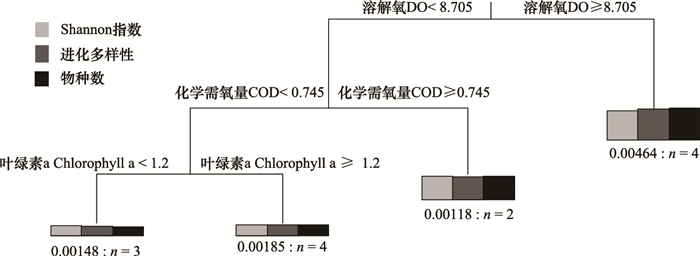
|
| 图 2 多元回归树分析影响细菌多样性的环境因子 Fig. 2 Multivariate regression tree analysis to identify the factors in shaping the bacterial diversity DO:溶解氧Dissolved oxygen; COD:化学需氧量Chemical oxygen demand |
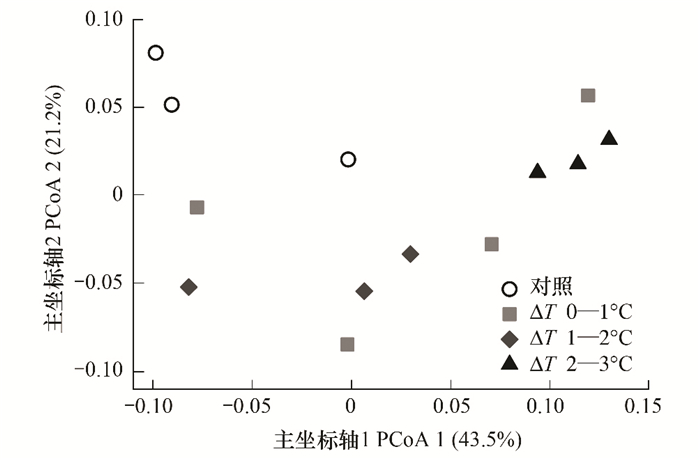
|
| 图 3 主坐标分析浮游细菌群落在不同增温幅度下的差异 Fig. 3 Principal coordinates analysis (PCoA) of the bacterioplankton community using UniFrac distance. Symbols are coded by temperature range |
由于水流、潮汐等因素可能会影响浮游微生物的空间分布特征, 导致自由态微生物的随机扩散而呈现无规则的分布[34]。因此, 利用空间距离-群落相似性模型分析浮游细菌的空间分布是否是无规则的, 发现随着站点间空间距离的增加, 浮游细菌群落的相似性递减(r=-0.582, P=0.026), 其周转速率为0.0013(图 4)。
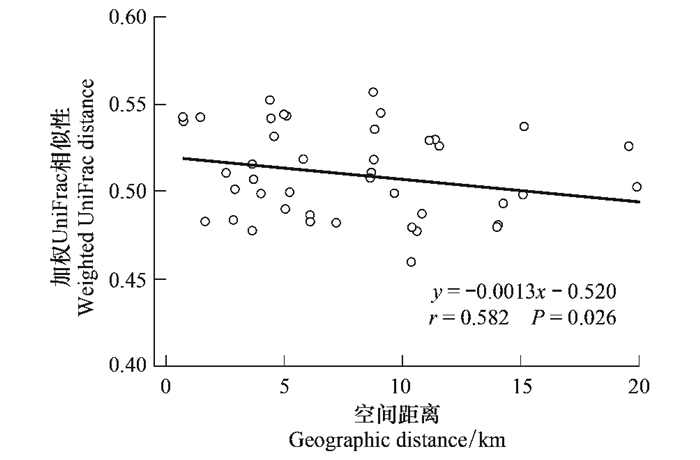
|
| 图 4 细菌群落相似性与空间距离的拟合相关性 Fig. 4 Correlation between bacterial community similarities (Weighted UniFrac distance) and geographic distances |
为了评估空间距离(作为扩散限制的指标)和水体理化性质对浮游细菌群落变异的相对贡献, 筛选与群落变异显著相关, 且膨胀因子小于20的环境因子。共4个环境因子, 包括温度(P=0.013)、油污浓度(P=0.004)、溶解氧(P=0.020)和叶绿素a(P=0.007)与群落变异显著相关。这些因子共控制了62.6%的群落变异, 剩余37.4%的群落变异未被解释(图 5)。其中, 空间距离解释了7.1%, 环境因子共解释了55.6%, 二者的交互作用解释了6.8%的群落变异。温度作为单一因子只控制了4.8%, 较低的细菌群落变异(图 5)。
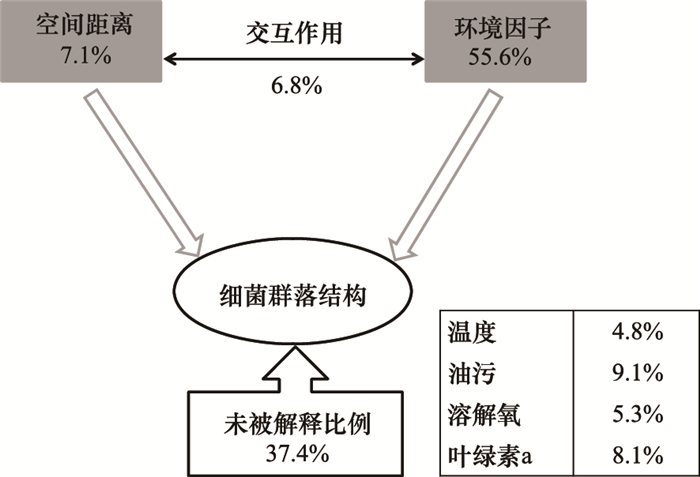
|
| 图 5 变异分配分析各环境因子对群落变异的相对贡献 Fig. 5 Variation partitioning analysis the relative contributions of geographic distance and water variables on the variation of bacterioplankton community structures |
以前的研究发现在细菌科的分类水平具有最高的生态功能内聚性[35]。因此, 在科水平筛选与海水温度显著相关, 且相对丰度较高(在所有样品中的平均值>0.2%)的细菌科。基于上述原则共筛选到11个细菌科, 其中3个科的相对丰度与增温幅度负相关, 即随着温度的增高相对丰度降低;其余8个细菌科与增温幅度正相关(图 6)。尽管这11个细菌科在对照样品中差别较大, 但在海水增温梯度影响下, 其相对丰度线性变化(图 6), 因此可以作为指示温排水增温幅度的敏感细菌指示科。
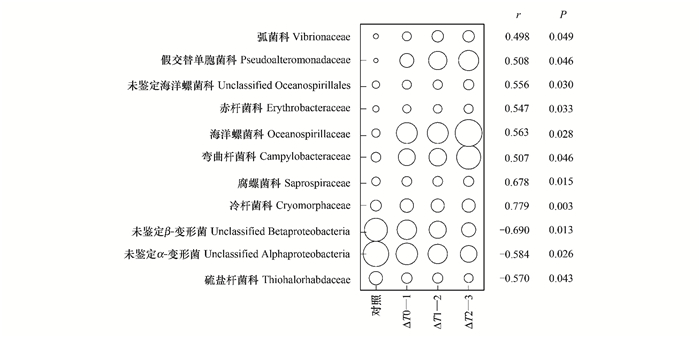
|
| 图 6 与增温幅度显著相关的11个细菌指示科 Fig. 6 Identification of the 11 bacterial families serving as bio-indicators along the temperature gradient 圆圈直径大小与相对丰度成比例, 右侧r和P值为不同站点温度与该科相对丰度的相关性分析 |
随着国家从战略层面对海洋环境的重视, 亟需评估大量电厂的兴建对环境的影响。本研究通过研究温排水增温梯度下的浮游细菌, 发现细菌群落不是随机分布的, 增温梯度显著地改变了细菌的群落组成, 并明确了导致群落变异的环境因子。重要的是筛选到了能够指示增温幅度的敏感细菌种群, 能够为评价温排水对生态系统的影响提供了新的检测指标。
3.1 增温改变了浮游细菌群落组成电厂温排水显著地增加了邻近海水的温度, 进而影响水体理化性质, 如化学需氧量、溶解氧等。研究发现溶解氧、化学需氧量和叶绿素a是影响细菌多样性的主要因素。溶解氧在促进微生物多样性的结果在其它研究中也有报道[36], 可能是溶解氧促进了好养细菌的增殖。叶绿素a和化学需氧量分别作为表征浮游植物生物量和水体有机质的综合指标, 能够为细菌提供代谢底物, 降低细菌的种群间竞争而提高细菌群落的多样性[37]。增温不是影响细菌多样性的主要因子, 但在不同增温范围内细菌群落组成差异显著, 表明细菌的群落组成比多样性对增温更敏感。类似的, 海水增温能够引起浮游动、植物群落的改变, 导致群落在时间尺度上的周转速率加快而降低生态系统的功能稳定性[2, 10]。近年来, 有证据表明微生物群落结构决定着生态功能对环境变化的响应, 如群落组成变化和功能变化显著相关[38];群落的变化伴随着代谢功能的改变[39];浮游微生物功能变化的程度与增温幅度正相关[16-17]。可见, 浮游细菌的群落组成和功能均能够对增温产生灵敏的响应。因此, 今后的研究需要关注电厂温排水增温导致的浮游细菌群落变化对生态功能产生的潜在影响。
3.2 驱动浮游群落变异的环境因子浮游细菌在海洋环境的物质能量循环过程中发挥着核心的生态功能[12], 因此明确细菌群落的空间分布特征和及其环境驱动因子, 对于明确生态系统的稳定性和功能至关重要。从经验上判断, 可能会认为水流和潮汐的作用会掩盖海水增温对浮游细菌的影响。然而, 在电厂温排水造成的增温梯度下随着空间距离的增加群落相似性衰减, 表明在水流和潮汐的干扰下仍能够检测到海水增温对细菌群落的影响, 浮游细菌的空间分布不是随机的。因此, 进一步利用变异分配分析来筛选驱动群落变异的环境因子, 其中油污浓度控制了最高比例(9.1%)的群落变异, 说明发电机的少量油泄漏会对浮游细菌结构造成重要影响。在自然环境中, 能够降解石油的微生物丰度在海洋环境中较低, 但在泄漏污染条件下能够促进这类微生物的生长, 从而改变细菌群落结构[40]。溶解氧和叶绿素a影响浮游细菌群落在以前的研究中也有报道, 认为这些因子能够分别促进好氧和好营养型细菌类群的生长[37, 41]。这些结果支持以前研究的推测, 在海水增温条件下浮游生物的组成将向异氧型的生态系统转变, 可能会进一步加速气候变暖的趋势[6, 16-17]。相比而言, 温排水增温对浮游细菌群落的直接影响较低, 仅解释了4.8%的群落变异, 因此增温主要通过改变水体的理化性质, 如溶解氧和浮游植物的初级生产力(叶绿素a浓度表征, 表 1)等, 间接影响浮游细菌的群落组成。类似的, 土壤增温也主要是通过增温的间接效应影响细菌群落的组成和功能结构[42-43]。此外, 随着空间距离的增加群落相似性衰减, 站点间的空间距离解释了7.1%的群落变异, 可能是由于浮游细菌的扩散速率低于环境因子对定殖的选择压力, 即通过物种选择(Species sorting)筛选适应环境的细菌种群, 造成非随机的空间分布, 表现为环境因子的组合解释了更高比例(55.6%)的浮游细菌群落变异(图 5)。因此, 即使在高流动性的近海水域, 也能够检测到温排水增温引起的浮游细菌群落变化, 为今后利用浮游细菌群落的变化来评价电厂对环境的影响提供了依据。
3.3 利用细菌科指示增温幅度研究浮游细菌对温排水增温的响应特征, 最终期望能够利用敏感的细菌种群来指示和评价电厂温排水对海洋环境的影响。本研究筛选到11个潜在的细菌指示科, 其相对丰度与增温幅度显著相关。重要的是这些细菌科相对丰度的变化特征与各科已知的生态功能相吻合。例如, 海洋螺菌科(Oceanospirillaceae)在海洋环境中广泛存在, 具有较高的丰度, 来源于该科的有些菌株能够降解复杂的石油污染物[44], 其丰度的增加可能是由于油污选择性地促进了这些细菌种的生长(油污浓度与增温幅度正相关, r=0.558, P=0.030, 皮尔森相关性)。来源于腐螺旋菌科(Saprospiraceae)的细菌具有降解和利用复杂碳源的能力[45], 该科相对丰度在增温条件的增加可能会为其它异养微生物提供可利用性碳源, 进一步促进异养微生物的呼吸作用。由于海洋生态系统对气候变暖的反馈取决于微食物网中浮游植物的初级生产力和异养微生物降解间的平衡[15], 这些异养细菌丰度的增加可能会加速气候变暖的趋势(正反馈作用)。此外, 长期的站位监测发现气候变暖引起的海水增温促进了弧菌的增殖[5];与本研究的结果一致, 弧菌科的相对丰度在增温梯度下递增。弧菌科(Vibrionaceae)和交替假单胞菌科(Pseduoalteromonadaceae)是常见的渔业条件致病菌, 其致病能力与温度正相关[4]。这些致病菌丰度的增加可能会对港内的渔业养殖造成潜在的负面影响。此外, 未被鉴定的α-和β-变形菌的相对丰度随增温幅度递减;由于缺乏这些种群相关的物种信息, 目前不能推测这些未被鉴定细菌丰度降低可能对生态功能的影响。考虑到这些潜在指示细菌科相对丰度与增温幅度的显著相关性, 今后可能通过设计科特异性引物, 以定量PCR检测指示细菌科的相对丰度, 评价增温对浮游细菌的影响。
综述所述, 电厂温排水显著地增加了邻近水域的温度, 增温主要通过改变水体理化性质的间接作用影响浮游细菌群落组成, 环境选择是造成群落变异的主要因素。浮游细菌群落的空间分布遵循空间群落-群落相似性衰减模型。此外, 本研究筛选到敏感的细菌指示科, 其丰度的变化与增温幅度显著相关, 可以评价增温对浮游细菌的影响并预测对生态功能潜在的影响。
| [1] | Hillebrand H, Soininen J, Snoeijs P. Warming leads to higher species turnover in a coastal ecosystem. Global Change Biology , 2010, 16 (4) : 1181–1193. DOI:10.1111/gcb.2010.16.issue-4 |
| [2] | Li X Y, Li B, Sun X L. Effects of a coastal power plant thermal discharge on phytoplankton community structure in Zhanjiang Bay, China. Marine Pollution Bulletin , 2014, 81 (1) : 210–217. DOI:10.1016/j.marpolbul.2013.08.006 |
| [3] | Chuang Y L, Yang H H, Lin H J. Effects of a thermal discharge from a nuclear power plant on phytoplankton and periphyton in subtropical coastal waters. Journal of Sea Research , 2009, 61 (4) : 197–205. DOI:10.1016/j.seares.2009.01.001 |
| [4] | Bally M, Garrabou J. Thermodependent bacterial pathogens and mass mortalities in temperate benthic communities:a new case of emerging disease linked to climate change. Global Change Biology , 2007, 13 (10) : 2078–2088. DOI:10.1111/gcb.2007.13.issue-10 |
| [5] | Vezzulli L, Brettar I, Pezzati E, Reid P C, Colwell R R, Höfle M G, Pruzzo C. Long-term effects of ocean warming on the prokaryotic community:evidence from the vibrios. The ISME Journal , 2001, 6 (1) : 21–30. |
| [6] | Sarmento H, Montoya J M, Vázquez-Domínguez E, Vaqué D, Gasol J M. Warming effects on marine microbial food web processes:how far can we go when it comes to predictions?. Philosophical Transactions of the Royal Society B:Biological Sciences , 2010, 365 (1549) : 2137–2149. DOI:10.1098/rstb.2010.0045 |
| [7] | 魏超, 叶属峰, 韩旭, 李道季, 过仲阳. 滨海电厂温排水污染生态影响评估方法. 海洋环境科学 , 2013, 32 (5) : 779–782. |
| [8] | 任敏, 刘莲, 何东海, 徐国峰, 毛伟宏. 试论滨海发电厂温排水对象山港赤潮的影响. 海洋开发与管理 , 2012, 29 (3) : 87–89. |
| [9] | Jiang Z B, Liao Y B, Liu JJ, Shou L, Chen Q Z, Yan X J, Zhu G H, Zeng J N. Effects of fish farming on phytoplankton community under the thermal stress caused by a power plant in a eutrophic, semi-enclosed bay:Induce toxic dinoflagellate (Prorocentrum minimum) blooms in cold seasons. Marine Pollution Bulletin , 2013, 76 (1/2) : 315–324. |
| [10] | 朱艺峰, 黄简易, 林霞, 杨莹, 邢超, 严小军. 象山港国华电厂强增温海域浮游动物群落结构和多样性的时空特征. 环境科学 , 2013, 34 (4) : 1498–1509. |
| [11] | 杜萍, 刘晶晶, 徐晓群, 陈全震, 曾江宁, 江志兵, 王琪. 象山港不同生境冬季浮游动物生态特征比较研究. 水产科技情报 , 2011, 38 (2) : 92–99. |
| [12] | Azam F, Malfatti F. Microbial structuring of marine ecosystems. Nature Reviews Microbiology , 2007, 5 (10) : 782–791. DOI:10.1038/nrmicro1747 |
| [13] | 裘琼芬, 张德民, 叶仙森, 郑珍珍. 象山港网箱养殖对近海沉积物细菌群落的影响. 生态学报 , 2013, 33 (2) : 483–491. |
| [14] | IPCC. Climate Change 2014:Impacts, Adaptation, and Vulnerability. IPCC, 2014. |
| [15] | Vázquez-Domínguez E, Vaqué D, Gasol J M. Ocean warming enhances respiration and carbon demand of coastal microbial plankton. Global Change Biology , 2007, 13 (7) : 1327–1334. DOI:10.1111/gcb.2007.13.issue-7 |
| [16] | Hoppe H G, Breithaupt P, Walther K, Koppe R, Bleck S, Sommer U, Jürgens K. Climate warming in winter affects the coupling between phytoplankton and bacteria during the spring bloom:a mesocosm study. Aquatic Microbial Ecology , 2008, 51 (2) : 105–115. |
| [17] | Wohlers J, Engel A, Zöllner E, Breithaupt P, Jürgens K, Hoppe H G, Sommer U, Riebesell U. Changes in biogenic carbon flow in response to sea surface warming. Proceedings of the National Academy of Sciences of the United States of America , 2009, 106 (17) : 7067–7072. DOI:10.1073/pnas.0812743106 |
| [18] | Zhou J Z, Deng Y, Zhang P, Xue K, Liang Y T, Van Nostrand J D, Yang Y F, He Z L, Wu L Y, Stahl D A, Hazen T C, Tiedje J M, Arkin A P. Stochasticity, succession, and environmental perturbations in a fluidic ecosystem. Proceedings of the National Academy of Sciences of the United States of America , 2014, 111 (9) : E836–E845. DOI:10.1073/pnas.1324044111 |
| [19] | Shade A, Peter H, Allison S D, Baho D L, Berga M, Bürgmann H, Huber D H, Langenheder S, Lennon J T, Martiny J B H, Matulich K L, Schmidt T M, Handelsman J. Fundamentals of microbial community resistance and resilience. Frontiers in Microbiology , 2012, 3 : 417. |
| [20] | López-Urrutia Á, San Martin E, Harris R P, Irigoien X. Scaling the metabolic balance of the oceans. Proceedings of the National Academy of Sciences of the United States of America , 2006, 103 (23) : 8739–8744. DOI:10.1073/pnas.0601137103 |
| [21] | Inskeep W P, Bloom P R. Extinction coefficients of chlorophyll a and b in N, N-dimethylformamide and 80% acetone. Plant Physiology , 1985, 77 (2) : 483–485. DOI:10.1104/pp.77.2.483 |
| [22] | Biddle J F, Fitz-Gibbon S, Schuster S C, Brenchley J E, House C H. Metagenomic signatures of the Peru Margin subseafloor biosphere show a genetically distinct environment. Proceedings of the National Academy of Sciences of the United States of America , 2008, 105 (30) : 10583–10588. DOI:10.1073/pnas.0709942105 |
| [23] | Xiong J B, Ye X S, Wang K, Chen H P, Hu C J, Zhu J L, Zhang D M. Biogeography of the sediment bacterial community responds to a nitrogen pollution gradient in the East China Sea. Applied and Environmental Microbiology , 2014, 80 (6) : 1919–1925. DOI:10.1128/AEM.03731-13 |
| [24] | Magoč T, Salzberg S L. FLASH:fast length adjustment of short reads to improve genome assemblies. Bioinformatics , 2011, 27 (21) : 2957–2963. DOI:10.1093/bioinformatics/btr507 |
| [25] | Caporaso J G, Kuczynski J, Stombaugh J, Bittinger K, Bushman F D, Costello E K, Fierer N, Peña A G, Goodrich J K, Gordon J I, Huttley G A, Kelley S T, Knighs D, Koenig J E, Ley R E, Lozupone C A, McDonald D, Muegge B D, Pirrung M, Reeder J, Sevinsky J R, Turnbaugh P J, Walters W A, Widmann J, Yatsunenko T, Zaneveld J, Knight R. QⅡME allows analysis of high-throughput community sequencing data. Nature Methods , 2010, 7 (5) : 335–336. DOI:10.1038/nmeth.f.303 |
| [26] | Edgar R C, Haas B J, Clemente J C, Quince C, Knight R. UCHIME improves sensitivity and speed of chimera detection. Bioinformatics , 2011, 27 (16) : 2194–2200. DOI:10.1093/bioinformatics/btr381 |
| [27] | Caporaso J G, Bittinger K, Bushman F D, DeSantis T Z, Andersen G L, Knight R. PyNAST:a flexible tool for aligning sequences to a template alignment. Bioinformatics , 2010, 26 (2) : 266–267. DOI:10.1093/bioinformatics/btp636 |
| [28] | DeSantis T Z, Hugenholtz P, Larsen N, Rojas M, Brodie E L, Keller K, Huber T, Dalevi D, Hu P, Andersen G L. Greengenes, a chimera-checked 16S rRNA gene database and workbench compatible with ARB. Applied and Environmental Microbiology , 2006, 72 (7) : 5069–5072. DOI:10.1128/AEM.03006-05 |
| [29] | De'ath G. Multivariate regression trees:a new technique for modeling species-environment relationships. Ecology , 2002, 83 (4) : 1105–1117. |
| [30] | Lozupone C, Knight R. UniFrac:a new phylogenetic method for comparing microbial communities. Applied and Environmental Microbiology , 2005, 71 (12) : 8228–8235. DOI:10.1128/AEM.71.12.8228-8235.2005 |
| [31] | Clarke K R. Non-parametric multivariate analyses of changes in community structure. Australian Journal of Ecology , 1993, 18 (1) : 117–143. DOI:10.1111/aec.1993.18.issue-1 |
| [32] | Xiong J B, Liu Y Q, Lin X G, Zhang H Y, Zeng J, Hou J Z, Yang Y P, Yao T D, Knight R, Chu H Y. Geographic distance and pH drive bacterial distribution in alkaline lake sediments across Tibetan Plateau. Environmental Microbiology , 2012, 14 (9) : 2457–2466. DOI:10.1111/emi.2012.14.issue-9 |
| [33] | Ramette A, Tiedje J M. Multiscale responses of microbial life to spatial distance and environmental heterogeneity in a patchy ecosystem. Proceedings of the National Academy of Sciences of the United States of America , 2007, 104 (8) : 2761–2766. DOI:10.1073/pnas.0610671104 |
| [34] | Finlay B J. Global dispersal of free-living microbial eukaryote species. Science , 2002, 296 (5570) : 1061–1063. DOI:10.1126/science.1070710 |
| [35] | Berry D, Schwab C, Milinovich G, Reichert J, Mahfoudh K B, Decker T, Engel M, Hai B, Hainzl E, Heider S, Kenner L, Müller M, Rauch I, Strobl B, Wagner M, Schleper C, Urich T, Loy A. Phylotype-level 16S rRNA analysis reveals new bacterial indicators of health state in acute murine colitis. The ISME Journal , 2012, 6 (11) : 2091–2106. DOI:10.1038/ismej.2012.39 |
| [36] | 熊薇, 郭逍宇, 赵霏. 湿地芦苇根结合好气细菌群落时空分布及其与水质因子的关系. 生态学报 , 2013, 33 (5) : 1443–1455. |
| [37] | Teeling H, Fuchs B M, Becher D, Klockow C, Gardebrecht A, Bennke C M, Kassabgy M, Huang S X, Mann A J, Waldmann J, Weber M, Klindworth A, Otto A, Lange J, Bernhardt J, Reinsch C, Hecker M, Peplies J, Bockelmann F D, Callies U, Gerdts G, Wichels A, Wiltshire K H, Gl ckner F O, Schweder T, Amann R. Substrate-controlled succession of marine bacterioplankton populations induced by a phytoplankton bloom. Science , 2012, 336 (6081) : 608–611. DOI:10.1126/science.1218344 |
| [38] | Reed H E, Martiny J B H. Microbial composition affects the functioning of estuarine sediments. The ISME Journal , 2013, 7 (4) : 868–879. DOI:10.1038/ismej.2012.154 |
| [39] | Xiong J B, He Z L, Van Nostrand J D, Luo G S, Tu S X, Zhou J Z, Wang G J. Assessing the microbial community and functional genes in a vertical soil profile with long-term arsenic contamination. PLoS One , 2012, 7 (11) : e50507. DOI:10.1371/journal.pone.0050507 |
| [40] | Harayama S, Kasai Y, Hara A. Microbial communities in oil-contaminated seawater. Current Opinion in Biotechnology , 2004, 15 (3) : 205–214. DOI:10.1016/j.copbio.2004.04.002 |
| [41] | Xiong J B, Zhu J L, Wang K, Wang X, Ye X S, Liu L, Zhao Q F, Hou M H, Qiuqian L L, Zhang D M. The temporal scaling of bacterioplankton composition:high turnover and predictability during shrimp cultivation. Microbial Ecology , 2014, 67 (2) : 256–264. DOI:10.1007/s00248-013-0336-7 |
| [42] | Zhou J Z, Xue K, Xie J P, Deng Y, Wu L Y, Cheng X L, Fei S F, Deng S P, He Z L, Van Nostrand J D, Luo Y Q. Microbial mediation of carbon-cycle feedbacks to climate warming. Nature Climate Change , 2012, 2 (2) : 106–110. |
| [43] | Xiong J B, Sun H B, Peng F, Zhang H Y, Xue X, Gibbons S M, Gilbert J A, Chu H Y. Characterizing changes in soil bacterial community structure in response to short-term warming. FEMS Microbiology Ecology , 2014, 89 (2) : 281–292. DOI:10.1111/fem.2014.89.issue-2 |
| [44] | Satomi M, Fujii T. The Family Oceanospirillaceae. The Prokaryotes: Springer, 2014491–527. |
| [45] | McIlroy S J, Nielsen P H. The FamilySaprospiraceae. The Prokaryotes: Springer, 2014863–889. |
 2016, Vol. 36
2016, Vol. 36




